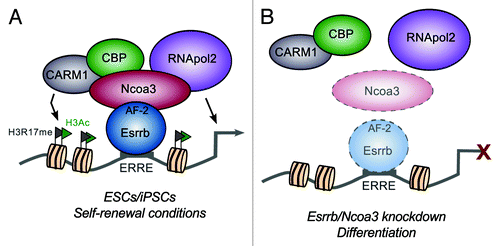Figures & data
Figure 1. Proposed model depicting the role of Esrrb and Ncoa3 at ESC-specific enhancers. (A) In pluripotent cells, Esrrb binds to ERR response elements (ERREs) at active enhancer regions, which also contain bound core proteins such as Nanog and Oct4 (not shown). AF-2-mediated recruitment of Ncoa3 is, in turn, essential for Esrrb activity, with Ncoa3 binding both epigenetic and basal transcription machinery complexes to bring about strong activation of target genes. (B) Upon conditions where Esrrb and/or Ncoa3 proteins are downregulated (faint color), their loss might lead to alterations in chromatin structure and destabilization of RNA polymerase II (RNApol2), thus triggering differentiation.
